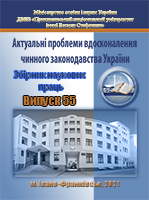Possibilities Usage Blockchain Technology For Protect Intellectual Property Rights In Ukraine
DOI:
https://doi.org/10.15330/apiclu.55.14-21Keywords:
blockchain, intellectual property rights, copyrights, literary works, works of arts.Abstract
In the article the author explores the prospects of using blockchain technologies to protect intellectual property rights. The purpose of this study is to identify the main advantages of this technology, analysis of foreign legislation and proposals for improving existing legislation. The analysis of activity of operating services on the basis of blockchain technology WIPO Proof, Blinded, Ascribe and practice of their application is carried out.
Promising areas of use of blockchain technology in the field of intellectual property should be: ensuring the automatic storage of data of applications for intellectual property rights; opportunity to confirm intellectual property rights; separations of access rights to the object of intellectual property rights.
Ensuring automatic storage of data of applicants for intellectual property rights. Services based on blockchain technology allow you to securely store user data. The reliability and completeness of the data rests with the user of the services.
Ability to confirm intellectual property rights. Analyzing advantages and disadvantages of blochchain technology, it should be noted that this technology will have a positive result in Ukraine, namely build on the basic technology of blockchain register of intellectual property rights. By analogy with the State Land Cadastral to blockchain technology.
Separation of access right to the object of intellectual property rights. The advantage of this service is the ability to enter into smart contracts, which are confidential because they are stored in encrypted form, reduces time and money. The parties can be sure that the terms of the agreement will be met, and no one will change them.
In conclusion, blockchain technology has significant prospects and provides an opportunity to qualitatively transform the field of intellectual property in the direction of providing reliable evidence of authorship, facilitating content control and user rights management.


